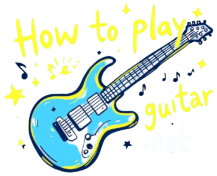Muting unused strings when playing power chords
by Dave
(NY)
How do I mute the other strings when playing power chords so that it doesn't sound so mushy?
Answer
First of all, you need to work on your picking, making it target only the strings that make up a power chord while avoiding accidental picking of the adjacent strings.
You can mute the adjacent strings by slightly touching them with any part of your available fingers on the fretting hand.
In the following example, when performing a power chord, the index and pinky fingers press the A and D strings, while the middle finger slightly touches the unused low E string, and the side of the pinky finger the unused G string.

You can also use your thumb to silence the low E string.

When you transition the fretting hand from one power chord position immediately to the next, without regard to whether it's on the same or different strings, the moment the hand takes off from the first chord, it "automatically" stops the strings from ringing, and in the very short interval of time until you play the next chord, there won't be any significant noise.
But if you need to pause before playing the next chord, like here:
the noise will occur. To avoid this, during breaks between chords, place the edge of your picking hand across the strings, as you do with the palm-muting technique.
